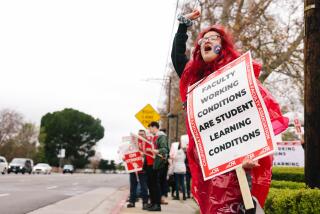American Professors: A NATIONAL RESOURCE IMPERILEDby Howard R. Bowen and Jack H. Schuster (Oxford University: $24.95; 322 pp.)
- Share via
An old gag in academia gives three good reasons for being a professor: June, July and August. But all professors, down deep, know the real reason--no other job leaves you more autonomy or gives you greater opportunity to do what you would do if you didn’t have to make a living. And no other job keeps you in such close touch with the arts and sciences at the roots of your culture at the same time that you re-discover every day what young people are thinking this year.
University faculties are a vital “national resource”--the resource that brings tradition face to face with new technological and social requirements. The resource that, every day, reaffirms tradition and creates new tradition.
But university faculties are going through a dangerous period. Howard R. Bowen and Jack H. Schuster, of the Claremont Graduate School, have done all of us (not just professors and university administrators and trustees) a great service by compiling this detailed and uncompromisingly academic book that surveys those difficulties.
From the middle 1950s--when both Sputnik and the birth rate headed upward--until the 1970s, the number of universities and colleges in the United States increased 60%. The number of students went up 400%. That led to a whole new context of higher education. Good faculty members were, obviously, at a premium. Pay scales--even prestige--went up.
But today the demand is down, and pay scales have eroded, creating an anomalous situation in which the best young faculty are better on the average than their elders, but in which many fine young scholars are unable to get jobs.
As a result, a startling decline has occurred in the number of first-rate graduate students who opt for an academic career. Increasing pay scales would help, obviously, but no sensible university wants faculty who (once a decent living is assured) are primarily in it for the money. So what is the problem? The authors of this fine book take a close but short-term look at the situation. Their recommendations for government and corporate assistance are sound even as they may not be realistic.
It should be stressed, however, that these authors take short views. The fact is that the university, and hence the faculty, is taking a very different place in society from its traditional one. Education enters more stages of the life course as a result of the democratization of longevity on the one hand, and the runaway rate of cultural innovation on the other. The age of undergraduates keeps rising as elders enroll; at the same time, young people and their parents clamor for specific job training at the expense of general education. Education has become a lifelong requirement--so has constantly renewed training in professional skills. The two are not the same thing. Until a few years ago, it made sense for professors to tell their students they should first be educated and only then trained in specialties. Students don’t believe it any more.
These and other changes mean that the responsibilities of faculty to the community as well as to students have changed. Faculty members are still role models for the young at the same time that they push back the frontiers of knowledge. But today they have to be role models for all of us: people who grow as they change with the torrential growth of knowledge and understanding. They should be men and women who can see beyond their own specialties to the emerging sciences and arts of the next era. One of the real difficulties with faculties--and it is one that these authors do not mention--is that instead of looking creatively at the requirements of the new society, they too often try to enshrine the status quo. Nothing could be further from the mission of the university.
Never has being a professor been such a challenge. This book makes us see a large part of the reason--but I hope these authors’ next book looks more fully into the changing role of the faculty as it reflects the dramatically changing role of the university in the societies that cradle it.






